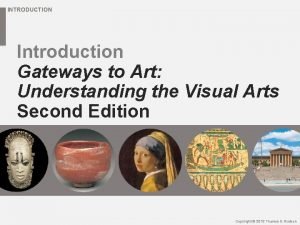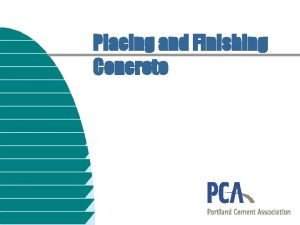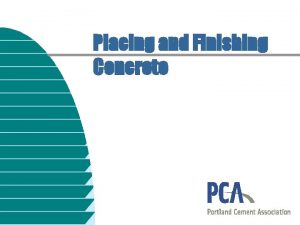Part 4 The Visual Record Placing the Arts































































- Slides: 63

Part 4: The Visual Record: Placing the Arts in Historical Context

Art History • The remaining chapters of your textbook cover major developments and movements in art from the earliest (Ancient Art) to the most recent times (Contemporary Art). • Art history is connected to and reflective of broader cultural developments. An understanding of the economic, social, and cultural structure is necessary to appreciate the visual records left by previous societies. • Art history analyzes: -the general characteristics of the art of each period/culture -the influence of earlier cultures on later ones -advances in thinking, technology, social development from one time period to the next and how that shows in their artistic output • History is constantly being revised as more information and objects are found.

Chapter 17 – The Ancient World Thinking Ahead: 1. What is a megalith? 2. What role did the ka play in Egyptian culture? 3. How did Lysippus challenge the Classical canon of proportions? 4. How did the ancient Romans respond to Greek art and culture?

Chapter Overview The Earliest Art Mesopotamian Cultures Egyptian Civilization River Valley Societies of India and China Complex Societies in the Americas Aegean Civilizations Greek Art Roman Art Developments in Asia

The Earliest Art

Prehistory – The Stone Ages • It is not until the emergence of modern humans, Homo sapiens, in the Paleolithic Era, that we find artifacts that might be called works of art. • The word “Paleolithic” derives from the Greek palaios, “old, ” and lithos, “stone, ” and refers to the use of stone tools, which represent a significant advance beyond the flint instruments used by the Neanderthal peoples. • Paleolithic—Old Stone Age.

Wall painting with three horses facing one another, Chauvet, Ardèche Gorge, France. c. 30, 000 BCE. Paleolithic images of large hunted animals found in cave paintings at Chauvet and Lascaux What were the function of these images? Some scholars propose that Paleolithic peoples believed that they had the ability to take control of the spirit of an animal if they physically drew an image of that animal. Prehistoric peoples may have believed this domination would empower them to face the reality of the hunt, essential to their existence.

Wall painting, Lascaux, France. c. 15, 000 BCE. At Lascaux Cave, scholars believe that small pockmarks on painted images suggest that the prehistoric peoples were ritually “killing” the animal with weapons before the actual hunt. Others, though, have pointed out that many of the animals depicted were not Paleolithic “game” animals—they were not hunted for food. www. culture. fr/culture/arcnat/lascaux/en/ In the absence of written records, we are left to give educated guesses as to why these early European settlers made these images.

Wall painting, Sulawesi island, Indonesia. c. 38, 000 BCE. A hand painted in an Indonesian cave dates to at least 39, 900 years ago, making it among the oldest such images in the world— older than Chauvet and Lascaux! An example of an archaeological study that rewrites the history of art. http: //news. nationalgeographic. com/news/2014/10/141008 -cave-art-sulawesi-hand -science/

Woman (once known as the Venus of Willendorf), Lower Austria. c. 25, 000– 20, 000 BCE. Limestone. height 4 ½ in. An icon of Paleolithic art--the earliest known representation of a woman Discovered by an archaeologist near the town of Willendorf, Austria in 1908 Most likely made by hunter-gatherers who lived in the area Why are her features exaggerated? The people who made this statuette lived in a harsh ice-age environment where heavy-set features and fertility would have been highly desirable.

Prehistory – The Stone Ages From Nomadic to Permanent Settlements Paleolithic—Old Stone Age. Paleolithic peoples were hunters/gatherers. Neolithic—New Stone Age. Neolithic peoples were farmers/herdsmen. • Around 8000 BCE, humans began to domesticate animals and cultivate food grains, practices that started in the Middle East and spread slowly across Greece and Europe for the next 6, 000 years, reaching Britain last. • Gradually, the Neolithic (New Stone Age) people abandoned temporary shelters for permanent structures built of wood, brick, and stone. • The difference in lifestyle is reflected in subject matter, media, and symbolism of Paleolithic and Neolithic art. Paleolithic art is usually portable, whereas Neolithic art is not, emphasizing the permanence of Neolithic villages.

Basin, Majiayao culture, Majiayao phase, Gansu Province, China. c. 3000– 2700 BCE. Earthenware with painted decoration. diameter 11 in. Neolithic ceramic The gradual shift from a Paleolithic nomadic lifestyle to an organized, agriculturally-based Neolithic society with domesticated animals is not only evidence of Neolithic people’s interest in acquiring a sense of order and control in their lives, but also constitutes the nascent stages of civilization.

Beaker with ibex, dogs, and long-necked birds, from southwest Iran. c. 5000– 4000 BCE. Painted terracotta. 28 × 16 cm. Neolithic ceramic Stylized animals including an ibex – a symbol of plenty

Stonehenge, Salisbury Plain (Wiltshire), England. c. 2000 BCE. In Northern Europe, especially Britain and France, a distinctive kind of monumental stone architecture was produced late in the Neolithic period. Known as megaliths, meaning “big stones, ” they were constructed without the use of mortar and represent the most basic form of architectural construction. These works must have required significant organization and problem-solving skills to create. Henge—stone circle of megaliths, often surrounded by a ditch with built-up embankments

Mesopotamian Cultures: Sumerians, Babylonians, Assyrians

Sumerian Culture • Between 4000 and 3000 BCE, irrigation techniques were developed on the Tigris and Euphrates rivers in Mesopotamia. • A complex society emerged. The Sumerians developed schools, libraries, laws, and the invention of writing, cuneiform, that was used to write the first novel, the epic of Gilgamesh

Worshippers and deities from the Abu Temple, Tell Asmar, Iraq. c. 2900– 2600 BCE. Limestone, alabaster, and gypsum. height of tallest figure 30 in. One of the differences between Prehistoric cultures (Paleolithic and Neolithic) and the complex societal structure of Sumerian culture is organized religion. These limestone statues are known as votive figures, or images dedicated to the gods. They were placed in a shrine or used for individual worship.

Ziggurat, Ur, c. 2100 BCE. Fired brick over mud brick core. The Sumerian’s most impressive surviving archaeological remains are the ziggurats, which are huge stepped structures with a temple or shrine on top. They tower over the flat plains and proclaim the wealth, prestige and stability of the city’s rulers and glorified its gods

Babylonian Culture • One of the most influential Mesopotamian cultures was that of Babylon, which rose to power under the leadership of Hammurabi in the 18 th century BCE.

Stele of Hammurabi. c. 1760 BCE. Basalt. height of stele approximately 7 ft. ; height of relief 28 in. Hammurabi and the codification of the law inscribed on a giant stele – an upright stone slab, carved with a commemorative design or inscription. Atop the stele, Hammurabi receives the blessing of Shamash, the sun god.

Assyrian Culture • After the fall of Babylon in 1595 BCE, victim of a sudden invasion of Hittites from Turkey, only the Assyrians, who lived in and around the city of Assur in the north, managed to maintain a continuing cultural identity. • By the time Assurnasirpal II came to power, in 883 BCE, the Assyrians dominated the entire region. He built a magnificent capital at Kalhu on the Tigris River.

Assurnasirpal II Killing Lions, from the palace complex of Assurnasirpal II, Kalhu (modern Nimrud, Iraq). c. 850 BCE. Alabaster. height approximately 39 in. A lion-hunting scene in low-relief The scene depicts the reigning king, Assurnasirpal II, standing in his chariot of galloping horses, pulling back his bow against the attacking lion

Egyptian Civilization

Egyptian Civilization • About the same time that Sumerian culture developed in Mesopotamia (c. 3000 BCE), Egyptian society began to flourish along the Nile River. • A polytheistic civilization – pharaohs and deities • The ka needed a body to live in, so a sculpted likeness was adequate • Egyptians preserved the bodies of the dead through mummification and provided their tombs with every luxury they could want in the afterlife

Palette of King Narmer (front and back) Hierakonpolis, Upper Egypt. c. 3000 BCE. Slate. height 25 in. The Palette of King Narmer is historically important represents the unification of Upper and Lower Egypt Named for king Narmer- his name appears in an early form of hieroglyphic writing at the center Using the hieratic scalethe ruler appears much larger than the other figures

King Khafre, Giza, Egypt. c. 2530 BCE. Diorite. height 66 1/8 in. Egyptian artists were skilled in creating lifelike three-dimensional sculptures-inthe-round. The figures were compact, solid, and blocklike which express a feeling of strength and permanence Like much of Egyptian art, the statue of King Khafre shows rigorous geometry.

Queen Nefertiti, Tell el Amarna. c. 1365 BCE. Painted limestone. height 19 5/8 in. Disruption of the polytheistic system under the rule of Emperor Akhenaten and his wife, Queen Nefertiti Introduction of monotheism Art from the reign of Akhenaten was different from previous and subsequent sculpture because it was much more naturalistic and informal. Is this a realistic portrait? Nefertiti’s features seem idealized.

River Valley Societies of India and China The Harappans, Mohenjo-daros, Shang dynasty

River Valley Societies of India and China • Indian civilization was born along the Indus River around 2700 BCE. The earliest Indian peoples lived in two great cities: Harappa and Mohenjo-daro. • The Indian civilizations eventually collapsed in 1800 BCE but left behind religious and artistic traditions that persist to this day. • In China, the Shang Dynasty ruled the Yellow River Valley by the second millennium BCE. The Shang kings displayed their royal authority with treasures made of jade, shell, bone, and lacquer.

Large water tank, possibly a public or ritual bathing area, from Mohenjo-Daro, Indus valley civilization. c. 2600– 1900 BCE. Governmental or religious center - a complex of buildings built atop a citadel. A giant pool – a public path or ritual space

Torso of a “priest-king, ” from Mohenjo-daro, Indus valley civilization. c. 200– 190 BCE. Steatite. height 7 7/9 in. Stone sculpture torso of a priestking demonstrates that the people of Mohenjo-daro were accomplished artists.

Spouted ritual wine vessel (Guang), Shang dynasty, early Anyang period. 13 th century BCE. Bronze. height 8 ½ in. Three-footed bronze vessels were created for domestic and ceremonial use. This is an exampleo of a guang, or wine vessel. Sophisticated bronzecasting technology

Complex Societies in the Americas Olmec

Complex Societies in the Americas • The earliest history of people in the Mesoamerica is still unclear, but there is evidence that a people called the Olmec settled in the lowlands of southern Mexico around 1500 BCE. • They built large ceremonial districts and created (sometimes monumental) art. • They built pyramids that probably were intended as man-made ritual volcanoes or portals into the earth.

Colossal head, Olmec culture. c. 900– 500 BCE. Basalt. height 7 ft. 5 in. The Olmec also left behind the very distinctive, helmeted Colossal Heads that probably were “portraits” of rulers. The Olmec eventually gave way to future civilizations like the Maya and Aztec, among others. This colossal head was found in La Venta, Mexico.

Aegean Civilizations Minoans, Mycenaeans

Aegean Civilizations • Impressive centers of power and wealth also appeared in the eastern Mediterranean, particularly with the Minoan civilization on the island of Crete and with Mycenae on the Greek Peloponnesus, the southern peninsula of Greece. • Peace-loving Minoans vs. warrior Mycenaens

The “Toreador” fresco, Knossos, Crete. c. 1500 BCE. height, including upper border, approximately 24 ½ in. Minoan civilization, Minotaur One of the most famous and bestpreserved wall paintings at a palace complex called Knossos depicts bull leaping. The action seen here may represent an initiation or fertility ritual.

The Warrior Vase, Mycenae. c. 1200 BCE. height approximately 14 in. Mycenaean potters created highly refined ceramics. Mycenaean pottery are the earliest Greek pottery to depict the human form. A krater – two-handled ceramic bowl for mixing water and wine, used in both feasts and as grave markers. Differing from the characteristic decoration of the Minoans, whose safety was insured by their island location, the war motifs of this vase reflect the more militaristic aspects of Mycenaean life. Although not realistically drawn, the decoration of the Warrior Vase provides a document of ancient defensive arms and armor. The helmeted Mycenaean warriors bear heavy shields and spears as they march into battle.

The Lion Gate, Mycenae, Greece, 1250 BCE. The walls are load-bearing construction, but the gate itself is post-and-lintel construction.

Treasury of Atreus, “Tomb of Agamemnon, ” Mycenae, Greece, c. 1250 BCE Beehive or tholos tomb— dome-shaped tomb in which the Mycenaeans buried their dead. These tombs were full of gold and silver, including masks of the royal dead, a burial practice similar to that of the Egyptians.

Greek Art

Greek Art • The rise of the Greek city-state, or polis, marks the moment when Western culture begins to celebrate its own human strengths and powers— the creative genius of the mind itself—over the power of nature. • The Greek passion for individualism, reason, and accurate observation of the world continued on even after the disastrous defeat of Athens in he Peloponnesian War in 404 BCE, which led to a great loss of Athenian power.

The Acropolis, Athens, Greece. rebuilt in the second half of the 5 th century BCE. The values of the Greek city-state were embodied in its temples. The temple was usually situated on an elevated site above the city, and the acropolis was conceived as the center of civic life. Construction of the Acropolis in Athens began about 450 BCE under the leadership of Pericles.

Nike, from the balustrade of the Temple of Athena Nike. c. 410– 407 BCE. Marble. height 42 in. An example of the Phidian style. Phidias was the sculptor who was in charge of all of the ornamentation and sculpture for the complex buildings on the Acropolis. Marked by naturalism, relaxed, effortless poses, athletic or casual movement, precise anatomical detail

Polyclitus Doryphoros, or “spear bearer” 450 BCE. Marble height 84 in. Polyclitus defined beauty as a function of proper proportion. He demonstrated the “perfect body” through mathematical proportion, symmetry, and balance. Polyclitus’s canon - the head is one eighth of the body’s height, and the shoulder width is one fourth of the total height of the body. Notice the contrapposto stance.

Apoxyomenos (The Scraper), Roman copy of an original Greek bronze by Lysippus. c. 350– 325 BCE. Marble. height 6 ft. 8 ½ in. Court sculptor to Alexander the Great, Lysippus challenged the Classical canon of proportions created by Polyclitus. Lysippus sculpted figures with smaller heads and slimmer bodies than those of Polyclitus. This lent Lysippus’s figures a sense of greater height.

Nike of Samothrace. c. 190 BCE. Marble. height approximately 8 ft. Artists strove for an ever greater degree of realism, and in the sculpture of the Hellenistic Age, we find an increasingly animated and dramatic treatment of the figure. The Nike of Samothrace, a symbol of victory, is a masterpiece of Hellenistic realism

The Laocoön Group, Roman copy, perhaps after Agesander, Athenodorus, and Polydorus of Rhodes. 1 st century CE. Marble. height 7 ft. The sculptor is no longer content simply to represent the figure realistically; sculpture must convey emotion as well.

Roman Art

Roman Art • Beginning in the 5 th century BCE, Rome dedicated itself to conquest, eventually creating an empire that included all areas surrounding the Mediterranean and that stretched as far north as present-day England. • Although the Romans conquered Greece (in 146 BCE), they regarded Greek culture and art as superior to any other. The Romans imported a large amount of Greek art, and in fact, much of our knowledge of Greek art comes from Roman copies. • The Roman Empire possessed a distinctly Greek character. Many of Rome’s artists were of Greek extraction.

Portrait of a Boy. early 3 rd century BCE. Bronze. height 9 in. Etruscan life-size bronze head influenced by the Greeks The finest metalworkers of the age

She-Wolf. c. 500 BCE. Bronze. height 33 ½ in. The Etruscan “Capitoline Wolf” -- the legendary wolf who nourished and saved the city’s founder, Romulus and his twin brother Remus Adopted by the Romans as a symbol of their civilization According to Roman tradition, Rome was founded in 753 BCE.

Augustus of Primaporta. c. 20 BCE. Marble. height 6 ft. 8 in. Discovered in Livia’s villa at Primaporta, near Rome, this sculpture illustrates the use of imperial portraiture for propaganda. The sculptor of this larger-than-lifesize marble statue adapts the orator’s gesture and ideal Greek proportions.

The Arch of Titus, Rome. c. 81 CE. Concrete with marble facade. height 50 ft. , width 44 ft. 4 in. The perfection of the arch and dome and the development of structural concrete, were the Roman’s major architectural contributions. But they were extraordinary monument builders. This is a triumphal arch that triumphant Roman armies would march through. It is composed of a simple barrel vault enclosed within a rectangle, and enlivened with sculpture and decorative engaged columns. Notice how the Romans used the Greek architectural orders.

Attributed to Apollodorus, Column of Trajan, Rome. 113 CE. Marble. height originally 128 ft. , length of frieze approximately 625 ft. The victory of the Roman emperor Trajan over the Dacians in back-to-back wars is carved in numerous scenes that spiral around a 126 -foot marble pillar in Rome known as Trajan’s Column. It’s a tale that reads like an ancient comic strip.

Attributed to Apollodorus, Lower portion of the Column of Trajan, Rome. 113 CE. Carved into the structure are 2, 662 figures in 155 scenes. Trajan appears in 58 of them. Viewers were meant to follow the story from bottom to top standing in one place rather than circling the column 23 times, as the frieze does.

Developments in Asia

Developments in Asia • At about the same time that Rome became establishing its imperial authority over the Mediterranean world, warring states in China were unified under the leadership of Qin Shihuangdi, who worked to achieve a stable society. • After the Qin’s collapse, the Han dynasty came to power, inaugurating over 400 years of intellectual and cultural growth.

The Great Wall, near Beijing, China. begun late 3 rd century BCE. Built to discourage nomadic invaders from the north

Model of a Multi-Storied Tower. Chinese, Eastern Han dynasty, 1 st century CE. Painted earthenware. 52 × 33 ½ × 27 in. This model of a house was found in a tomb, presumably for use of the departed in the afterlife. It gives us an idea about domestic architecture in China at this time.

Lady of Dai with Attendants. Han dynasty, after 168 BCE. Painted silk banner from the tomb of Dai Hou Fu-ren, Mawangdui Tomb I, Changsha, Hunan, China. Silk. height 6 ft. 8 ¼ in. The quality of Han silk is evident in a silk banner from the tomb of the wife of the Marquis of Dai discovered on the outskirts of present-day Changsa in Hunan. Painted with scenes representing on each of three levels: the underworld, the earthly realm, and the heavens, it represents the Han dynasty’s conception of the cosmos.

The Great Stupa, Sanchi, Madhya Pradesh, India, view of the West Gateway. founded 3 rd century BCE, enlarged c. 150– 50 BCE. Shrine height 50 ft. , diameter 105 ft. Elsewhere in Asia, the philosophy of Buddha, “The Enlightened One” was taking hold. This is one of the earliest surviving examples of a stupa - domelike structure evolved from burial mounds These were built in sacred locations and often contained relics Houses some of the ashes of the cremated Buddha and serves as a devotional site Relief sculptures cover the gates and depict stories from Buddha’s life without directly depicting him The devout walk around the stupa in a ritual path
 Creative arts term 3
Creative arts term 3 Specimen record observation
Specimen record observation Extended essay art examples
Extended essay art examples Reverie allan houser
Reverie allan houser Victorian curriculum visual arts scope and sequence
Victorian curriculum visual arts scope and sequence Seeing as reading explanation
Seeing as reading explanation Panofsky meaning in the visual arts
Panofsky meaning in the visual arts Emerging media definition
Emerging media definition Visual arts subject
Visual arts subject Victorian curriculum the arts
Victorian curriculum the arts Oil record book part 1 entries example
Oil record book part 1 entries example Oil record book part 2 entries example
Oil record book part 2 entries example Apa yang dimaksud dengan pemrograman konvensional
Apa yang dimaksud dengan pemrograman konvensional Part whole model subtraction
Part whole model subtraction Unit ratio definition
Unit ratio definition Brainpop ratios
Brainpop ratios Technical object description example
Technical object description example The heart of the entire beverage operation.
The heart of the entire beverage operation. The part of a shadow surrounding the darkest part
The part of a shadow surrounding the darkest part Part to part variation
Part to part variation Sucking reflex disappear
Sucking reflex disappear Sucking reflex disappear
Sucking reflex disappear Righting reflex baby
Righting reflex baby Periapical
Periapical Placing an order
Placing an order Placing pins in teeth
Placing pins in teeth Wac 296
Wac 296 Geometry practice 6-1 classifying quadrilaterals answers
Geometry practice 6-1 classifying quadrilaterals answers Placing an order sample letter
Placing an order sample letter Concrete control joint spacing
Concrete control joint spacing Goat restraint
Goat restraint Bc and ad timeline
Bc and ad timeline Timeline before christ
Timeline before christ Joist stabilizer plate
Joist stabilizer plate Placing wilted lettuce in cold water
Placing wilted lettuce in cold water Hình ảnh bộ gõ cơ thể búng tay
Hình ảnh bộ gõ cơ thể búng tay Frameset trong html5
Frameset trong html5 Bổ thể
Bổ thể Tỉ lệ cơ thể trẻ em
Tỉ lệ cơ thể trẻ em Chó sói
Chó sói Tư thế worm breton
Tư thế worm breton Bài hát chúa yêu trần thế alleluia
Bài hát chúa yêu trần thế alleluia Các môn thể thao bắt đầu bằng tiếng chạy
Các môn thể thao bắt đầu bằng tiếng chạy Thế nào là hệ số cao nhất
Thế nào là hệ số cao nhất Các châu lục và đại dương trên thế giới
Các châu lục và đại dương trên thế giới Công thức tiính động năng
Công thức tiính động năng Trời xanh đây là của chúng ta thể thơ
Trời xanh đây là của chúng ta thể thơ Cách giải mật thư tọa độ
Cách giải mật thư tọa độ Phép trừ bù
Phép trừ bù Phản ứng thế ankan
Phản ứng thế ankan Các châu lục và đại dương trên thế giới
Các châu lục và đại dương trên thế giới Thể thơ truyền thống
Thể thơ truyền thống Quá trình desamine hóa có thể tạo ra
Quá trình desamine hóa có thể tạo ra Một số thể thơ truyền thống
Một số thể thơ truyền thống Cái miệng nó xinh thế
Cái miệng nó xinh thế Vẽ hình chiếu vuông góc của vật thể sau
Vẽ hình chiếu vuông góc của vật thể sau Thế nào là sự mỏi cơ
Thế nào là sự mỏi cơ đặc điểm cơ thể của người tối cổ
đặc điểm cơ thể của người tối cổ Ví dụ về giọng cùng tên
Ví dụ về giọng cùng tên Vẽ hình chiếu đứng bằng cạnh của vật thể
Vẽ hình chiếu đứng bằng cạnh của vật thể Phối cảnh
Phối cảnh Thẻ vin
Thẻ vin đại từ thay thế
đại từ thay thế điện thế nghỉ
điện thế nghỉ




















































































